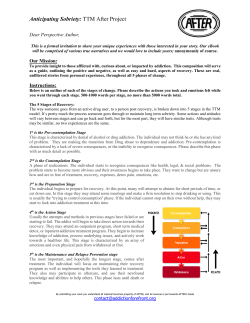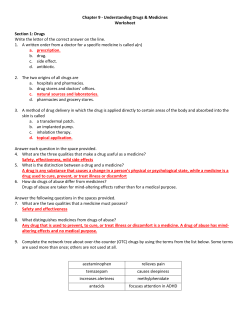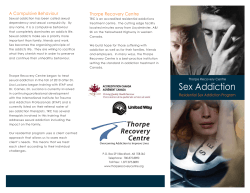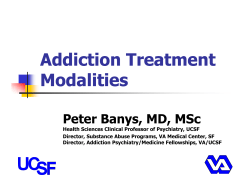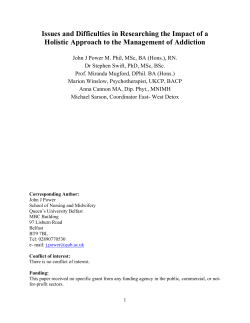
The Medical Model: Addiction is a Brain Disease
THE MEDICAL MODEL: ADDICTION IS A BRAIN DISEASE Judith Martin, MD Medical Director of Substance Use Services San Francisco Dept. Public Health disclosures • Dr. Martin has no conflict of interest to disclose. • Dr. Martin’s bias is that evidence-supported, safe treatment for SUDs should be equitably available throughout our system of care, including medication treatment. • Dr. Martin’s bias is that continuing education improves patient care. • Dr. Martin will indicate if she is discussing off-label use of medications. Educational Objectives for this talk: • 3 learning objectives • - compare addiction to other chronic diseases • - hear about brain adaptations in addiction • - list three medications that might help a patient with SUD ADDICTION AS A CHRONIC ILLNESS Chronic relapsing condition which untreated may lead to severe complications and death. ADDICTION AS CHRONIC DISEASE: IMPLICATIONS • It is treatable but not curable. • Adjustment to diagnosis is part of patient’s task. • There is a wide spectrum of severity. • Retention in treatment is key. • Best treatment is integrated: referrals to specialists, behavior and habits must change, medications may be needed. Addiction is similar to other chronic illness. • Review of adherence to treatment and relapse rates in asthma, hypertension and diabetes: • There are high relapse rates in diabetes (30 to 50%), hypertension (50-70%) and asthma (50 to 70%) with recurrence of symptoms that require additional medical care. • Comparison to addiction: • 40 to 60% return to active use after treatment discontinuation of treatment. • Argument by analogy: addiction is a chronic disease, we should not expect good outcomes from simple detox, or for treatment that ends after 30 days. • McLellan etal: “Drug Dependence, a Chronic Medical Illness: Implications for Treatment, Insurance,and Outcomes Evaluation. “JAMA, 2000;284(13): 1689-95 Types of science we use: • Science of behavior change: • Stages of change • Cognitive behavior therapy • Motivational incentives • Listening for language of change: can do, should do, wish I could do, will do and reflecting (motivational interview) • Medical Science: • Brain chemistry, receptors, transmitters, transporters, inhibitors, agonists • Co-occurring conditions: needle related infections, psychiatric complications, overdose rescue, liver damage, etc. ASAM definition (American Society of Addiction Medicine) • Addiction is a primary, chronic disease of brain reward, motivation, memory and related circuitry. Dysfunction in these circuits leads to characteristic biological, psychological, social and spiritual manifestations. This is reflected in an individual pathologically pursuing reward and/or relief by substance use and other behaviors. • http://www.asam.org/docs/publicy-policystatements/1definition_of_addiction_short_411.pdf?sfvrsn=0 Effects on the brain: • Addictive substances are initially pleasurable. • The ‘reward centers’ of the brain are stimulated. (limbic system) • Flooding of the brain with dopamine is a major effect. • The reward centers of the brain are normal parts of us that make us glad, help us enjoy life and respond normally to other people close to us. Changes with continual use: • Regular, habitual use of addictive substances lead to ‘salience’ of the drug, and brain changes called ‘neuroadaptation’ • Reward center is ‘hijacked’, can no longer respond to normal stimuli in the same way. ( the ‘outside’ stimulus works better now than the person’s own brain chemicals) • Physical dependence produces tolerance , withdrawal and craving Neuroadaptation of reward centers: • Description in NIDA’s “Science of Addiction”: • “(the drug user)…eventually feels flat, lifeless, and depressed, and is unable to enjoy things that previously brought them pleasure.” • http://www.drugabuse.gov/publications/science-addiction What keeps people using drugs? • Is it because they remember the euphoria and endlessly • • • • seek it? (positive reinforcement) It is because they have felt the pain of the lack of drug so much they fear it? (negative reinforcement) Which becomes more ‘salient’? For a recent debate in print about this see: Wise and Koob; “The Development and Maintenance of Drug Addiction” Neuropsychopharmacology (2014) 39, 254–262. Recovery includes brain recovery: • During and after addiction treatment there is brain healing • Some changes may be permanent, or take a long time to heal • These changes have been studied with psychological tests and also with brain imaging (scans) Quotes from articles about brain recovery: • cognitive dysfunction may linger for up to an average of 1 year post-detoxification from alcohol. Addict Biol. 2013 Mar;18(2):203-13 • Cognitive impairment reflecting CNS disruption in chronic solvent abusers can resolve within two years of abstinence. Drug Alcohol Depend. 2011 Nov 1;118(23):180-5. • One month of abstinence was sufficient to improve various attentional and executive domains in cocainedependent subjects. Drug Alcohol Depend. 2014 May 24. pii: S0376-8716(14)00875-8. Dopamine transporters recover with abstinence Volkow et al., 2001 Physical dependence and Withdrawal • What happens when you have stopped using opiates or drinking alcohol? • Opiates: Sick or ‘kicking’, • pupils big, sweating, shaking, blood pressure rises, vomiting, diarrhea, sniffling and tears. • Alcohol: Anxiety, tremors, (DTs, seizures can occur). Medication to calm the brain has become standard for stopping alcohol in dependent drinkers. Intoxication • ( “High” or “loaded” or “drunk”) • Opiates: sedated, head drops (“Nodding”), eyes close, sleep, breathing slows (can stop in overdoses). • Alcohol: loss of inhibitions, might do things that otherwise would not, loss of coordination, vomiting, blackouts, fainting (passing out). Smell of alcohol is typical. • Stimulants: ‘amped’, talking fast, body moving, unable to sit or sleep or focus (overdose: heart attack or stroke), sometimes stimulant psychosis. CRAVING • Preoccupation with the substance • Vivid dreams and nightmares about using substance • Automatic behaviors to get substance “Abusable” substances: partial list • Alcohol***** • Cocaine • Methamphetamine • Heroin**** • Pain relievers**** • Sedatives such as benzodiazepines** • Marijuana** • Tobacco*** • Sugar (food) • Other: • * one asterisk per available medication treatment. Examples of addiction treatment medications: • Alcohol withdrawal treatment: benzodiazepines (usually for five • • • • • • • • days)(some studies with anticonvulsants –off label) Alcohol craving: naltrexone, topiramate (off label), acamprosate Alcohol deterrent: disulfiram Opioid withdrawal symptoms: methadone, clonidine (off label), buprenorphine (buprenorphine studied in teens, approved for over 16) Opioid maintenance (craving): methadone, buprenorphine(methadone and buprenorphine can be used in pregnancy) Opioid blockade: naltrexone Opioid overdose reversal: naloxone Stimulant use has no proven medication treatment Tobacco cessation: nicotine replacement, bupropion, varenicline. Examples of very effective medications: opioid maintenance medications • May provide up to 80 % of effect of treatment in medication-assisted treatment. • Discontinuation leads to high relapse rates • There is a dose-response relationship • Outcome on many fronts: needle use, criminal activity, illicit opioid use, craving, adherence to treatment. Treatment Outcome Data, Methadone maintenance. • 4-5 fold reduction in death rate (except first week) • reduction of drug use • reduction of criminal activity • engagement in socially productive roles • reduced spread of HIV • excellent retention (see: Joseph et al, 2000, Mt. Sinai J.Med) Dose Response Methadone Simulated 24 Hr. Dose/Response At steady-state in tolerant patient “Loaded” “High” Normal Range “Comfort Zone” Subjective “Sick” w/d Objective w/d 0 hrs. Time Opioid Agonist Treatment of Addiction - Payte - 1998 24 hrs. Relapse to IV drug use after MMT 105 male patients who left treatment Percent IV Users 100 82.1 80 72.2 60 57.6 45.5 40 28.9 20 0 IN 1 to 3 Treatment 4 to 6 7 to 9 10 to 12 Months Since Stopping Treatment Adapted from Ball & Ross - The Effectiveness of Methadone Maintenance Treatment, 1991 Opioid Agonist Treatment of Addiction - Payte - 1998 Recent Heroin Use by Current Methadone Dose % Heroin Use 100 80 60 40 20 0 0 10 20 30 40 50 60 70 Methadone Dose, in mg. Ref: J. C. Ball, November 18, 1988 Slide adapted from Tom Payte 80 90 100 HIV CONVERSION IN TREATMENT 35% 30% 25% 20% IT OT 15% 10% 5% 0% Base line 6 Month 12 Month 18 Month HIV infection rates by baseline treatment status. In treatment (IT) n=138, not in treatment (OT) n=88 Source: Metzger, D. et. al. J of AIDS 6:1993. p.1052 Opioid Maintenance Pharmacotherapy - A Course for Clinicians - 1997 Crime among 491 patients before and during MMT at 6 programs Crime Days Per Year 300 250 200 Before TX During TX 150 100 50 0 A B C D E F Adapted from Ball & Ross - The Effectiveness of Methadone Maintenance Treatment, 1991 Opioid Agonist Treatment of Addiction - Payte - 1998 Mean Heroin Craving: 16 Week Completers of buprenorphine trial. Mean Craving Score 50 45 1 mg 4 mg 8 mg 16 mg 40 35 30 25 20 15 1 2 3 4 5 6 7 8 9 10 11 12 13 14 15 16 Week of Study Remaining in treatment (nr) Buprenorphine Maintenance/Withdrawal: Retention 20 15 10 Control 5 Buprenorphine 0 0 50 100 150 200 250 Treatment duration (days) 300 350 (Kakko et al., 2003) Summary: • Addiction is similar to medical chronic disease in need for long-term treatment and relapse rates. • Addiction is associated with brain changes in the reward pathways. Recovery improves brain function. • Addiction treatment medications are used along with behavior science in treatment of addiction • Addiction treatment medications are used to ease discontinuation of drug use, and to support long-term recovery activities. Most of them relieve withdrawal and craving.
© Copyright 2025
